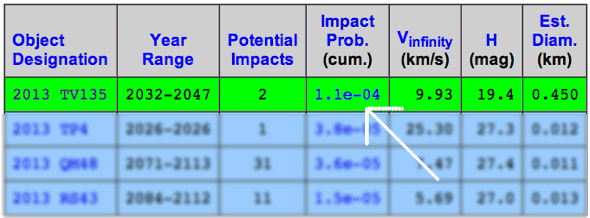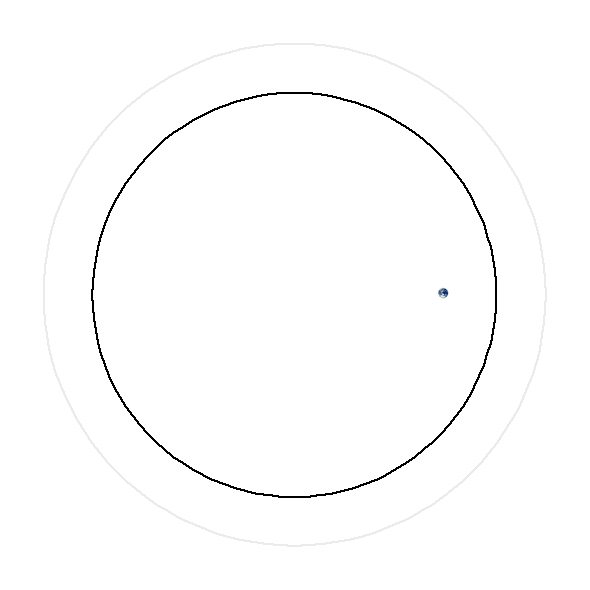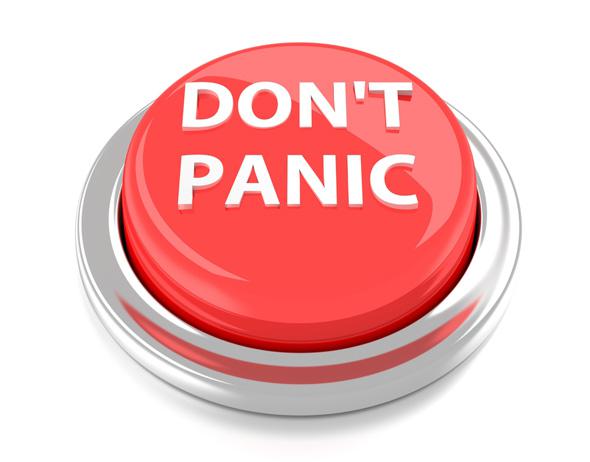“Never tell me the odds!”
— Han Solo, known for dodging asteroids
I recently wrote about a newly discovered asteroid called 2013 TV135. This 400-meter-wide rock has an orbit that takes it out from the Sun past Mars and dips it inward to just inside Earth’s orbit. The orbit is tilted with respect to Earth, but it does sometimes get fairly close to Earth.
When it was discovered on Oct. 8, astronomers projected its path forward in time to see just how close it might get. They found that in August of 2032 it may give us a close shave indeed: Given what they knew at the time, they calculated that there was a 1 in 63,000 chance of an impact.
As I wrote before, that number needs to be taken with a 400-meter-wide grain of salt. It’s essentially impossible to predict where an asteroid will be 19 years from now based on a week’s worth of observations. Over time, as we get more information on it, we’ll be able to nail down its orbit. Chances are an impact will be ruled out.
However, a few days ago a BABloggee sent me an email alerting me that the JPL Near Earth Object Risk Assessment website had listed the odds of an impact at 1 in 14,000. That means an impact is more likely! Should we panic?
My advice is to heed Douglas Adams’s advice: Don’t panic. Counterintuitively, having the chance of an impact go up at first is natural as more observations come in, but it’s still far more likely that the chance of an impact will drop to zero as time goes on. Even though at first this seems weird, the reason behind this is actually pretty simple.

Table by NASA/JPL
Because we don’t know the exact position, speed, and direction of an asteroid at first, projecting the orbit into the future makes it fuzzy. If you pick some time, say 19 years from now, there is a most likely position you can calculate for the rock, but really, statistically speaking, it could be anywhere inside a largish volume of space.
If the Earth is also inside that volume of space at the same time, then there is a chance of impact. But the volume is large, and the Earth small. That’s why, at first, the chance of an impact is usually pretty small.
So why does the chance then go up with more observations?
One way to think of this is to reduce it to a two-dimensional problem, which is easier to imagine. It’s not wholly accurate, but it’s just to give you an idea of how this works.
Picture a big circle hanging in space. At some future time, all we can say is that the asteroid will pass somewhere through that circle; it might be dead-center, or it might be near the edge. Now let’s say the Earth is also inside that circle but off-center:
Since the asteroid could pass through this circle anywhere inside it, the chance of it hitting the Earth is really just the ratio of the area of the Earth to that of the big circle. In the case here, I drew the circle with 50 times the diameter of the Earth. The ratio of the areas is 2,500 to 1 (area scales as diameter squared), so the chance of an impact is only 1/2,500 or 0.04 percent. Pretty low!

Illustration by Phil Plait
Now let’s say that more observations have nailed down the orbit a little better. The circle representing its probable location gets smaller. Let’s say it shrinks to 40 times the Earth’s diameter:
Note that the Earth is still inside the smaller circle. So now the odds of an impact are 1 in 1,600, or 0.06 percent. That’s higher! That means an impact is more likely. Or is it?

Illustration by Phil Plait
Now let’s say we get even better observations, and the circle gets even smaller, this time 25 times the Earth’s size:

Illustration by Phil Plait
Hey, wait a sec. The Earth is now outside the circle! That means the odds of an impact drop a lot. You might think the chance becomes zero, but really I’m hugely simplifying a much more complex issue; this is an analogy. In reality the chance won’t go completely to zero once the Earth is outside the target region because that circle isn’t really a hard-edged reality in space; it’s more of a big fuzzy region. Still, unless the Earth is placed just so, as time goes on the mathematical chance of an impact drops ( … I almost wrote, “like a rock”, so, um, yeah).
This is what happened with the asteroid 99942 Apophis back in 2004. At first, estimates for an impact were about 1 in 200, and that chance quickly rose to a gulp-inducing 1 in 37 (a 2.7 percent chance of impact). That’s still low, but given the consequences, a bit too high for my taste. However, as the orbit was refined further, the chance dropped, and then in early 2013 an impact was finally ruled out.
This is likely to be the case for TV135 as well. The first estimates of an impact chance were made with only eight days of observations; we now have 13 days, which is marginally (though not much) better. I fully expect we’ll see the chance of an impact go up even more for a while — as of Oct. 23 the chance had risen marginally to 1 in 10,000, which is still pretty small — but given some time I also expect the chance will probably drop once again.
To be honest, of course, I can’t guarantee that, but it’s the way I’d bet (cripes, most people would scoff and walk past any table in a casino that gave 10,000-to-1 odds of a win). And not to be too ominous, but even if this rock winds up missing us, there are a lot more out there. We’ve only mapped 10,000 out of a million or so dangerously large near-Earth objects, or about one percent of them. As I’ve said many times, we need more eyes on the sky, and a plan in place if we ever do spot one where the chance of an impact increases over time… and doesn’t change its direction.
Tip o’ the Whipple Shield to asteroid expert Don Yeomans for help with this topic.
